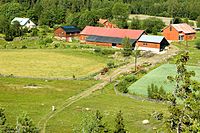
Photo from wikipedia
This article uses panel data from the Living Standards Measurement Study-Integrated Surveys on Agriculture for Uganda to assess the farm-level effects of nonfarm employment on agricultural intensification and productivity change.… Click to show full abstract
This article uses panel data from the Living Standards Measurement Study-Integrated Surveys on Agriculture for Uganda to assess the farm-level effects of nonfarm employment on agricultural intensification and productivity change. A sample selection model is used to account for both unobserved heterogeneity and potential simultaneity between agricultural production and nonfarm income. Results show that nonfarm employment can have differential impacts on farm technology intensity and productivity. Nonfarm income is found to have a positive impact on farm hired labor and improved seed intensity; a negative effect on on-farm family labor use; and no significant impact on fertilizer, soil water management, and joint use of farm technologies. The econometric evidence also indicates that agricultural productivity declines as nonfarm income increases. Taken together, our findings reveal important trade-offs between nonfarm employment and income and farm productivity growth under smallholder agriculture. The results indicated that targeted policies are required to reduce these potential trade-offs between nonfarm employment and agricultural intensification and productivity change.
Journal Title: Agricultural Economics
Year Published: 2017
Link to full text (if available)
Share on Social Media: Sign Up to like & get
recommendations!